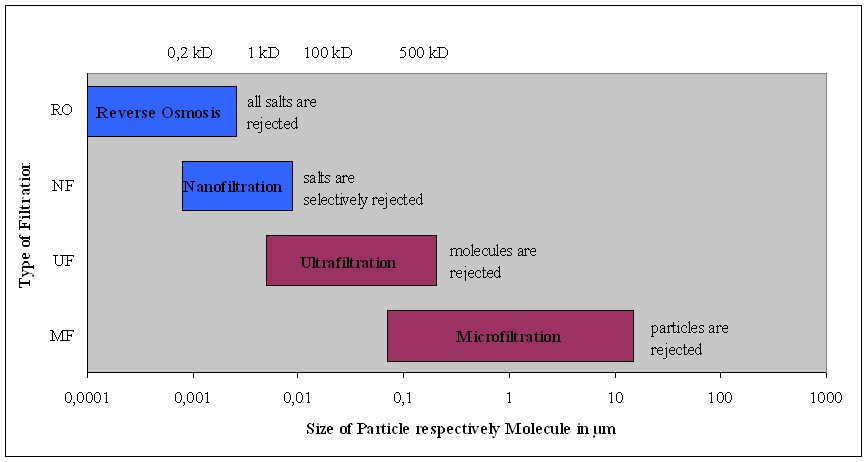Water Treatment

The distinction between the different types of the membrane is not clear. Sharp boundaries are not existing. Therefore the terms becomes indistinct.
The most simple classification is done by the rejected substances. With microfiltration exclusively particles are rejected - diffusion processes do not play a role. With the finest microfiltration membrane some of the largest molecules are rejected - the range of ultrafiltration begins. The most common parameter for characterising an ultrafiltration membrane is the "molecular weight cut off" MWCO. The unit is Dalton (D) respectively kilo-Dalton (kD). If a membrane has a MWCO of 100 kD, 90% (in some extent 95%) it will reject 90% of the particles with a moleculare weight of 100 g/mol. Larger particles are rejected better, smaller particles worse.
Some producers of membranes counts ultrafiltration to the range of microfiltration, because predominantly hydraulic processes occur that affect flow and rejection. In the lower range of pore size diffusion processes becomes stronger and hydraulic processes take a beck seat.
By some authors the transition to pure diffusion membranes (reverse osmosis) is called nanofiltration. Here some of small molecules and large salts are rejected at least partial. Large salt ions like calcium and sulfate are rejected to high amounts (e.g. 95%), smaller ions like sodium and chloride has only rejections of 40-60%.
If smaller salts are rejected to high percentages the range of reverse osmosis is reached. In this range only diffusion processes are important. Pores, that you imagine as small holes, are not existing. Only gases are diffusing nearly untouched. For this reason permeate of a reverses osmosis membran has a lower pH than the feed water: the carbonic acid in form of carbon dioxide diffuses through the membrane, in contrast the buffer capacity (e.g. hydrogen carbonate) not. The carbon dioxide in the permeate forms carbonic acid and lowers the pH.
From microfiltration to reverses osmosis the needed pressure is rising. Microfiltration is normally done under or slightly over 1 bar, because only the mechanical resistant of the membrane must be overrided. Reverse osmosis need in the extrem range (landfill seepage water) up to 200 bar. The higher the salt concentration the higher the osmotic pressure the higher the needed operation pressure for the membrane.

To get water for a fresh or sea water aquarium, normally you have to treat the tap water before.
- If the composition of the ions (total hardnes, carbonate hardnes / alkalinity, electrical conductivity) in the water is o.k., you should choose a block filter. This will reduce the concentration of organic substances and filters particles larger than 5 µm.
- If only particles and bacteria should be removed, please take the micro filtration.
- If all substances (particles, salts, hardnes, conductivity, organic substances) should be removed, a reverse osmosis unit is the choice.
Spare for your water treatment unit can be found here.
